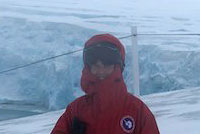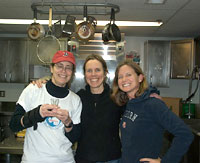

 | |||||||||||||||
|
|
Journals 2008/2009Megan O'Neill
May 3, 2009 What a full day! The station crew got to enjoy their first day off in two weeks with some leisure activities, while the science crew was busy in the lab. Jody and Bruce began the dissection of the C. gunnari, and I got to assist. It was incredible to see these fish dissected, as they are the “white blooded” species or one of the icefish without hemoglobin and myoglobin. Opening them up for the tissue from the heart, brain, liver and pectoral muscle was amazing because the red color of blood oozing out during dissections was not apparent. Just bizarre to see colorless liquid and a heart that was slightly tan in color only due to the density of mitochondria, as Bruce told me. Bruce also told me about some great books describing these fish and others in some books in the lab library. One is particularly wonderful, Antarctic Fish Biology by Joseph Eastman. This book goes through easy to read details of exactly how and why the fish of Antarctica are so unique. Which is described as attributed to the distinct boundaries of the benthic species due to the long expanse of abyssal plains of the ocean floor after the separation of the continents from seafloor spreading and the lack of connection to temperate oceans. These fish developed their unique characteristics over millions of years of adaptation to the cold water. After lunch, the wind subsided some (or so I thought) and the weather seemed to be cooperative enough to allow a hike up the glacier. Several people had already been up and back and had success skiing on a backside called, “Bonaparte.” I was anxious to get up to the top and check out the scenery and get some fresh air. I put on an extra layer, grabbed my googles, camera and some yaktrax (for those of us in South Alabama who don’t have experience with snow gear, these are fittings that slide over the bottom of your boots with metal grips to make walking across ice easier – and they work extremely well!). As I made my way up the glacier, the wind picked up with each step. I was so very thankful that I had grabbed those goggles, because they sure kept my face warm as the snow being blown off the glacier pelted me! By the time I made it to the top, I had to be extra careful not to release a glove while attempting to snap photos because it would have certainly been blown to the South Pole! I also had to be aware of the flag markers and the signs posted to avoid ending up in a crevasse in the ice! Being able to look out over the other side despite the snow and cloud cover was super exhilarating! What a beautiful landscape of snow, rocks, ice and glaciers. Spectacular. On Sundays, the chefs enjoy their day off as well, so the rest of us have the choice to either cook for the station or enjoy leftovers from the week. Lisa and I decided to volunteer, as she wanted to cook Spaghetti alla Puttanesca and I found a cranberry apple crisp recipe in a Moosewood for a Crowd cookbook, which is one of my favorite recipes from home. Cooking for Sunday night also made me feel at home, as we have Kilborn Family night dinners on Sundays! Cooking for thirty was a new challenge for Lisa and I, so thank goodness Eric (chef) and Ken were around to show us where to find our ingredients in the enormous pantry and to use equipment like the fabulous RotoCoupe food processor. I whizzed through chopping up vegetables with this contraption and have got to get one at home! Kristin, Jody and Irina helped with the bread, salad and olives tray and set up the dining area with tablecloths like an Italian bistro! Jeff helped with labeling and the spaghetti cooking (8 lbs!). And it all came together for a great dinner with lots of full bellies! Another exciting aspect of the day was being able to access Skype. Normally, this is not permitted due to the limited satellite transmission, but we have an exciting interview this Thursday via Skype – Dr. Bruce Sidell is being interviewed by Oprah! The episode will air toward the end of May, and will be entitled, “Where in the Skype are you?” Dr. Sidell has been selected to be interviewed for his knowledge of Palmer Station and Antarctica as he has studied icefish here for over 20 years. In order to prepare for the transmission, we have been able to use the station computer to Skype friends and family! It is just incredible to be able to see and talk to people at home! We can even take the laptop outside in the day and give them a “tour” of the station! This definitely makes us feel closer to home than we are! What a treat! I decided that my overriding theme for today was “equipment.” The equipment makes everything so much easier and technology is such a wonderful thing – from the lab utensils, to the googles, yaktraks, RotoCoupe and Skype. Go Science!
|
||||||||||||||


